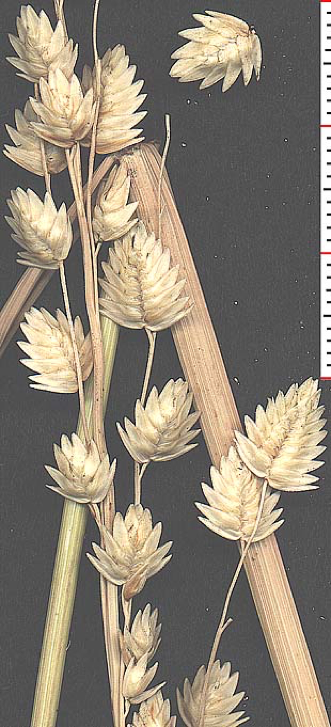by Tasia North, 2018 Doris Duke Conservation Scholar
Four weeks in, four weeks to go, in my internship with Sky Island Alliance.
The sun sets on a hard day’s work
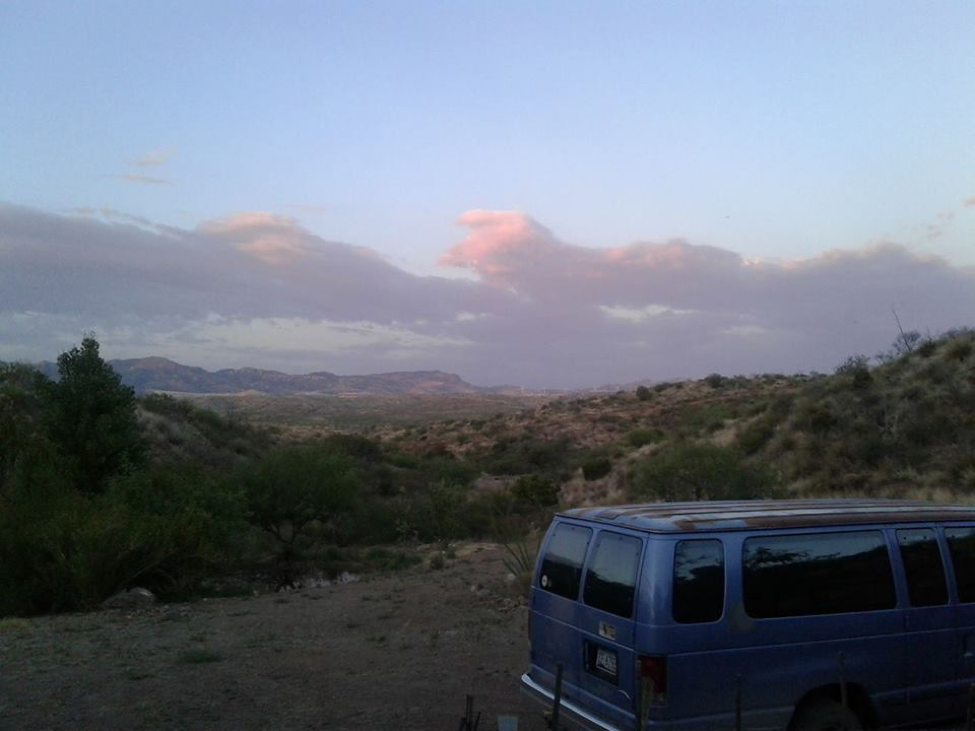
This was taken at Sowls Pond out in the Galiuro Mountains. Last year Sky Island Alliance built several ponds and planted a whole bunch of native plants around them. I went out in early June with a group to monitor progress and success of the ponds. Many of the plants had survived and the ponds are doing so well! I saw countless butterflies, dragonflies, bees, birds, and bats enjoying the water and the surrounding flowers, and it was great to see so much wildlife there.
Water is precious!
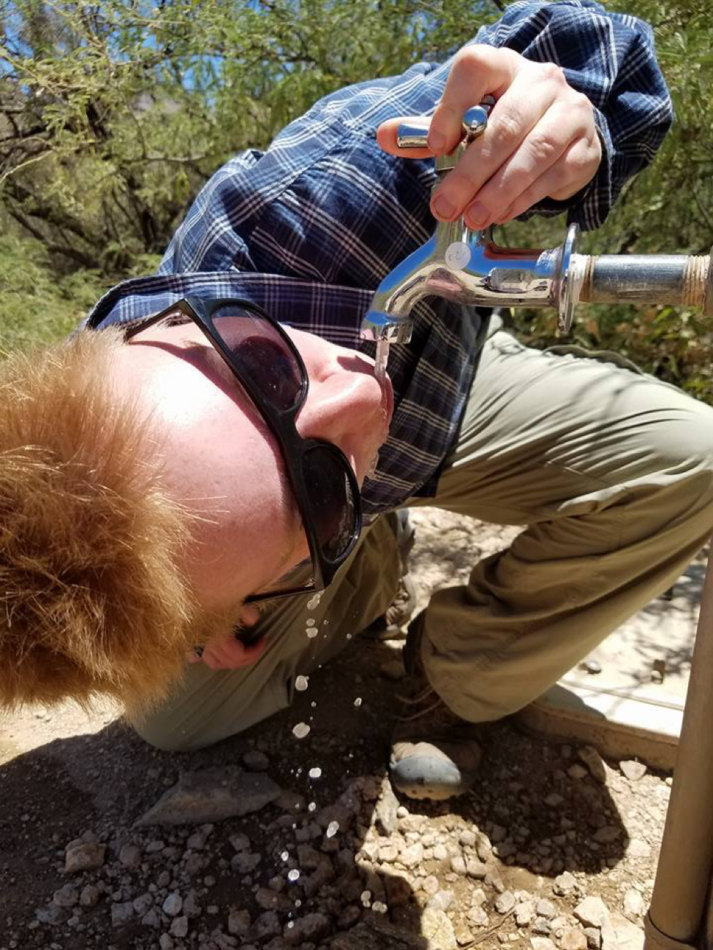
Being in the desert makes me think about water differently. I grew up at the base of the Teton Watershed up in Idaho, which, while still technically a desert (receives less than 25 centimeters of rain per year) is nothing like this one. People water their green lawns in the middle of the day, and you never have to worry about finding potable water because all the water is potable and it’s everywhere. It’s a very different thing when you’re hauling water in to bone-dry Bear Canyon in the Santa Catalina Mountains for some baby native plants so they can survive another month until the monsoon rains come. I’ve never so carefully watered plants before, nor have I been so acutely aware of how much water I myself consume. This was one of my earlier field work excursions here in Arizona, and I completely underestimated how much water I needed. Luckily the spigot at the trailhead was potable, and I have learned to carry much more water with me.
Restoring the land after wildfire

Gila Cliff Dwellings National Monument in New Mexico has been my favorite trip so far. There was a major fire that went through the area several years ago, so we were there to do post-fire restoration work on a hillside that bordered the main trail up to the cliff dwellings. We spread seed balls, pulled up invasive plants, and made far too many jokes. I really love doing restoration work. Humans spend so much time degrading the land we live on, and I often feel so powerless to do much about it. The little things I do to lessen my impact are great but don’t have anywhere near the large-scale effect that we need if my grandkids are going to be able to enjoy nature the way that I do. I really love doing something to actively restore an area, especially where the effects of our work are visible like they were at Gila Cliffs. We got rain the day after we spread all those seed balls, and I hope that those little seeds got all the moisture they need to survive and hold that soil in place for a long time to come.
Hot springs relaxation
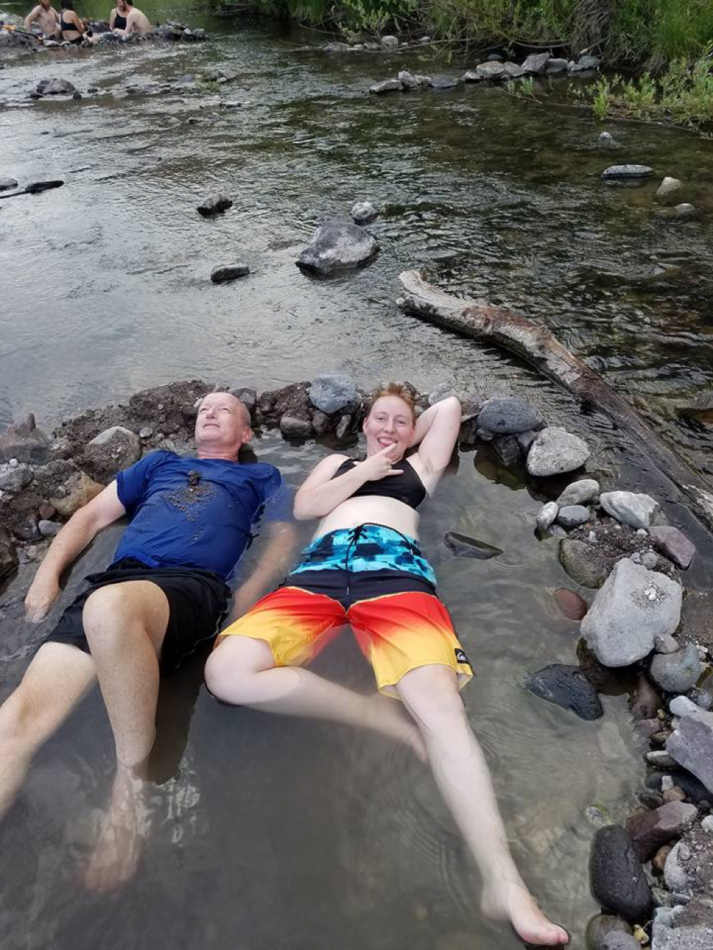
This was the first natural water I had seen since coming down to Arizona, and I had to drive to New Mexico to get it! This was taken at the hot springs at Gila Cliffs and they were glorious. They were shallow and only had room for a few people at a time, but it was peaceful and relaxing, and I had great company. I’ve really enjoyed every volunteer that we have worked with in the month that I’ve been here. I’ve found them to be an interesting, eclectic, and welcoming group of people, and I’ve thoroughly enjoyed getting to work alongside them. Tom here is no exception; we had a great 6-hour car ride together and a great time chatting in this hot spring.
Foiled by the fence!

Bob Harms: Eragrostica superba
The Los Fresnos Ranch in Sonora, Mexico shares a border with the United States. There’s a beautiful grassland on both sides of the barrier, the large dirt road the only thing that visually distinguishes one part of that grassland from another. This border is such a huge deal politically and socially, yet it’s quite literally a made-up line in some dirt. It’s always seemed rather silly to me that members of my own species can’t come visit me because somebody drew a line in the middle of this grassland. This particular day we were in Los Fresnos surveying for an invasive grass called Eragrostica superba. It has a distinctive inflorescence but otherwise blends in with the rest of the dry grass around it. Since most of us weren’t grass experts we needed a sample so everyone knew what to look for before we could start surveying. We had spent maybe 45 minutes wandering the Mexican hillside looking for it, determined it wasn’t in that area, and got in the truck to drive to the next site. Next thing I knew the driver slammed on the breaks and hopped out of the car exclaiming that they had found the grass… on the other side of the border fence… in America… where we couldn’t reach it or look at it closely. It was maybe 7 feet from us but we couldn’t touch it, so I settled for this picture. The superba is that bigger green clump next to the road on the other side of the fence. Below is a closer look at the grass, the inflorescence is quite pretty and very easy to pick out in a field, even a field on the other side of a fence!
Discovering agave in nature

This picture was also taken at the Los Fresnos Ranch in Sonora, Mexico, where we tugged down this dry stalk to see if there were still seeds inside during an agave survey. (There were!)
Agave are definitely one of my favorite plants in the Sonoran Desert. Plant-pollinator interactions have fascinated me since I started learning about science and nature. Agave are a new plant to me. I had heard of them, but only for the products they produce. The wild plants are majestic and fascinating creatures. While at the Borderlands Restoration greenhouse, we learned some interesting tidbits about agave. The migratory long-nosed bats are their sole pollinators. Agaves need to produce flowers in order to sexually reproduce and create genetically different offspring. Humans, in order to make our tequila and agave syrup, harvest the heart of the plant before the flower can be produced. We do this because the plant uses all of its nectar in the making of the stalk and flower, so if we let it flower there is nothing to harvest! But then, when long-nosed bats fly through, they have nothing to eat or pollinate. The pollination done by bats gives agave the genetic diversity it needs to resist disease and generally be a successful plant. The lack of healthy mature agave leads to less food for bats, which causes declines in bat populations. Fewer bats means less pollination occurring in agave plants, which leads to a weaker agave population and eventually, less food for bats. And so on and so forth. This is why I’m studying ecology, I love how complex nature is, how everything effects everything and nothing happens in a vacuum. It’s complicated, but I really love it.
Sunset on the border
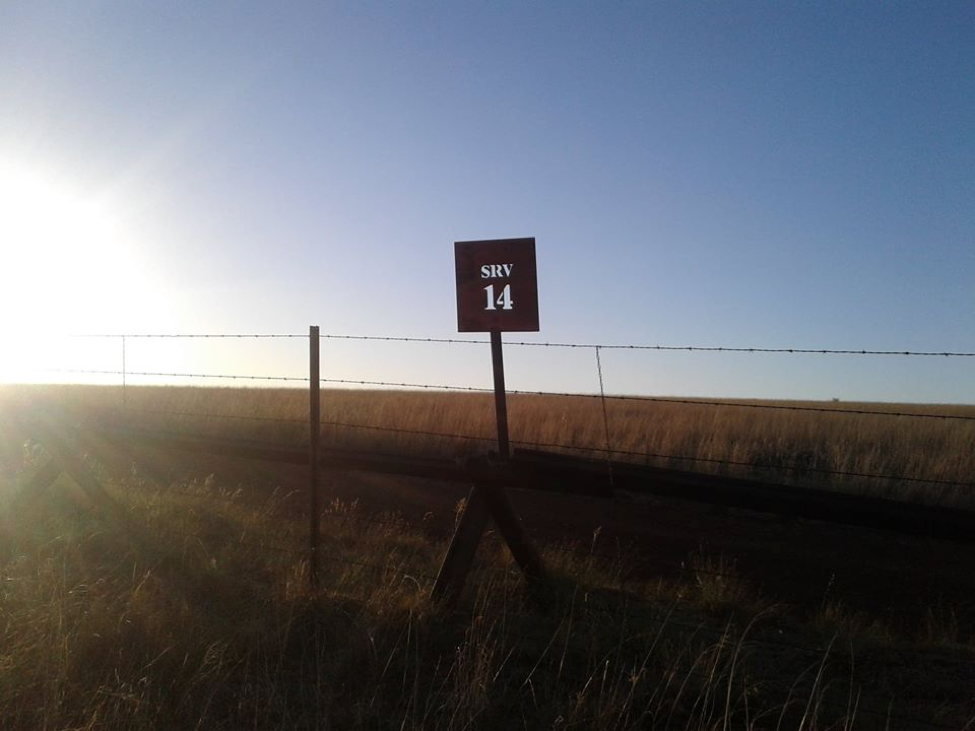
This picture was taken with my cellphone out of the back of a moving truck on a bumpy dirt road while going very fast. I took probably 10 photos of this view because I thought it was pretty the way the sun silhouetted the border fence against the blue sky and the how it made the dry grass look almost golden. All of those photos were trash except for this one, and I have no idea how it turned out so clear, but I’m glad it did.
Tiny beauty on the trail
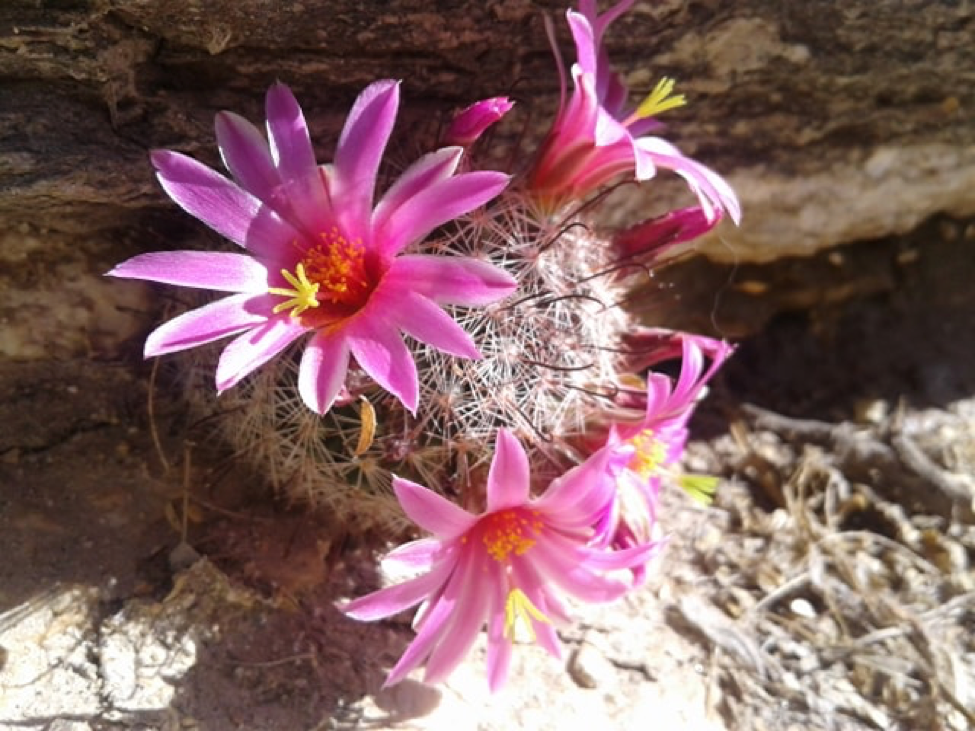
Everyone told me that the desert would come alive once there was a bit of rain, but I certainly wasn’t expecting to see flowers like this! This is in Bear Canyon on the trail up to Seven Falls. I was up there to haul water out to plants that had been placed this spring. The flowers were all over the trail and stunning. I’m no expert on cactus identification, but I’m pretty sure that this is a pincushion cactus in the genus Mammillaria.
My six-legged friend
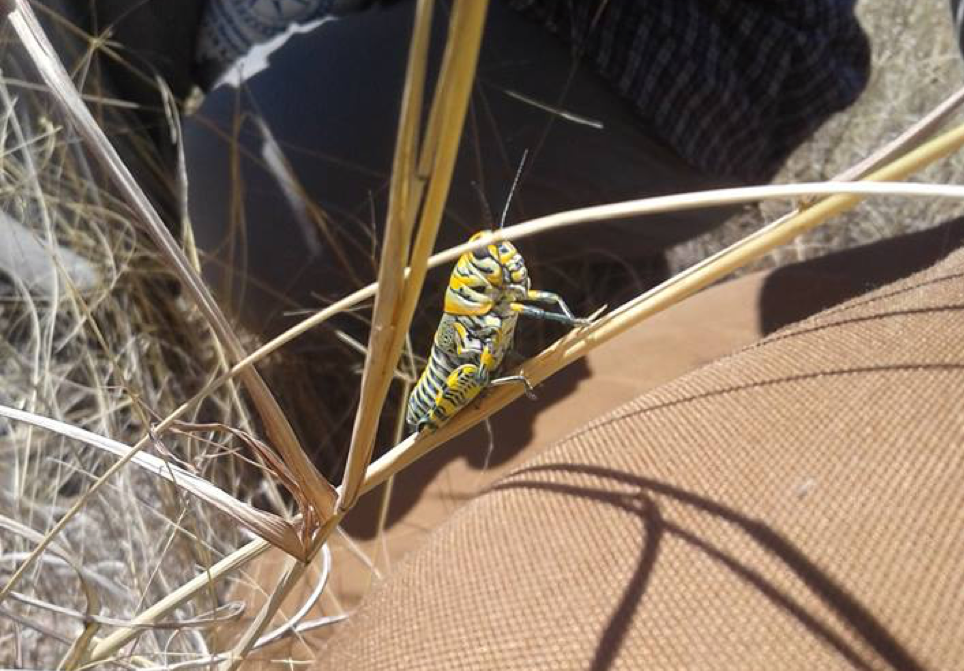
I am the biggest bug nerd. I think they’re so cool and beautiful! I found this stunning creature in Mexico at the Los Fresnos Ranch while doing grass surveys. This is the Dactylotum bicolor, or the painted grasshopper. It’s definitely one of my top two favorite grasshoppers that I’ve come across so far in my 22 years of being alive!

